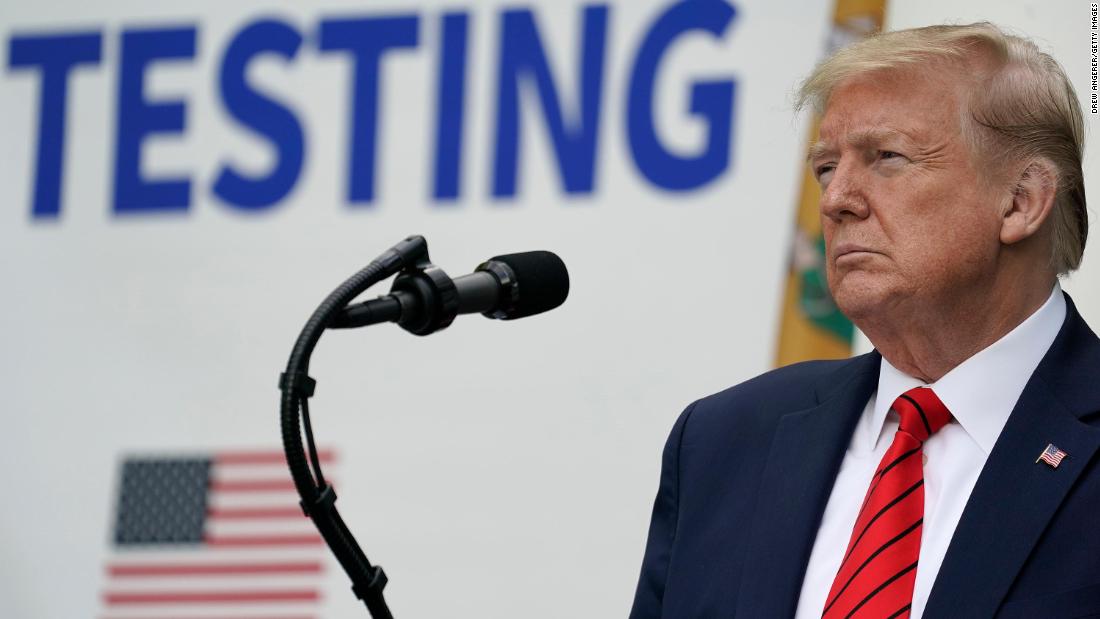Trump officials deflect blame for US death toll, escalate reopening push
[ad_1]

The effort follows Trump’s repeated early denials that the virus would be a problem for the United States and claims that his administration had it under control months ago.
Azar appeared to indicate that the inequities in the US health system, especially involving minorities, were to blame for the level of fatalities in the United States and said the administration had forged a “historic result” in preventing the pandemic from overwhelming the capacity of hospitals.
“Unfortunately the American population is … very diverse,” Azar told CNN’s Jake Tapper on “State of the Union.”
“It is a population with significant unhealthy comorbidities that do make many individuals in our communities, in particular African American, minority communities particularly at risk here because of significant underlying disease health disparities and disease comorbidities — and that is an unfortunate legacy in our health care system that we certainly do need to address.”
Azar insisted that he didn’t mean to say that so many Americans had died because they were unhealthier than people abroad. But he added that the country had a “significantly disproportionate burden of comorbidities … (including) obesity, hypertension, diabetes,” adding that “these are demonstrated facts that do make us at risk for any type of disease burden.”
A patient has comorbidities when they have two chronic diseases at the same time. Azar stressed that he was not trying to fault people because they had such conditions and was merely pointing out that that put them at higher risk of complications from Covid-19.
Navarro meanwhile singled out the CDC, led by Trump appointee Dr. Robert Redfield, for the early failures on coronavirus testing, reflecting deepening tensions between the agency and the White House.
“Early on in this crisis, the CDC, which really had the most trusted brand around the world in this space — really let the country down with the testing,” Navarro, a trade adviser drafted into the coronavirus effort, said on NBC’s “Meet the Press.”
“Not only did they keep the testing within the bureaucracy, they had a bad test and that set us back,” Navarro said.
“This administration has shown time and time again that it has a problem with science. We are giving them science and they don’t seem to want it,” the official told CNN’s Nick Valencia.
The big gamble of reopening
The new politicization of the pandemic came as the country transitions from trying to halt the virus in its tracks to living with it until a vaccine or therapies are found.
Almost all states are now open to varying degrees, although stay-at-home orders remain in some worse-hit areas. There are some signs of hope with deaths easing in New York and tentative shoots of economic recovery emerging as businesses are pried open.
But Texas, one of the most ambitious early openers, recorded its highest new case load yet, and crowded parks and boardwalks in other states raised the possibility the virus could find new footholds.
The political jousts and medical uncertainties that emerged over the weekend reflect the likelihood that the path back to normality will come in fits and starts and without the clear moment of victory that Trump keeps declaring is imminent.
Still, the President, who badly needs a rebound in the economy as he contemplates November’s election, is becoming even more bullish on his predictions of recovery.
Calling into an NBC charity golf challenge in one of the first unofficial sporting events after two months of lockdowns, Trump pledged that normality was not far away, contradicting the warnings of health experts and many governors.
“We want big, big stadiums loaded with people. We don’t want to have 15,000 people watching Alabama-LSU, as an example,” Trump said, referring to upcoming college football games which usually draw massive crowds.
“We want to have big crowds, and now, right now, that’s not what they’re planning, but you never know what happens. Things can happen very quickly, and we’re looking at vaccines, we’re looking at cures and we are very, very far down the line,” the President said. Trump also maintains that the reason why the US has the most cases of Covid-19 is that it has tested more people than any other nation. His claim is correct but does not take into account the fact that a number of countries have tested a higher proportion of their populations.
Trump’s push for a return to big crowds at sporting events may clash with the policies pursued by governors to keep a lid on the virus even as they slowly begin to open their states.
“The idea of having stadiums filled with 80-plus-thousand people, strangers coming together across their differences, as much as we want to see that happen … the health consequences could be profound and devastating and set back all the progress we have made,” California Democratic Gov. Gavin Newsom told CNN.
Administration pushes for swift reopening but concerns grow over Texas
Despite the caution in states worst hit by the virus, both Azar and Navarro said the time had come to reopen the country and sought to convince Americans that it is safe to come out of their homes.
“In almost half of our reporting counties, we have had not a single death,” Azar told Tapper.
“Sixty-two percent of our Covid cases come in just 2% of the reporting counties in the United States. So, these are very localized determinations,” Azar said, while cautioning that local conditions needed to determine the pace of opening.
Navarro, while not backing up his claims with evidence, said that keeping the country locked down would kill more people than opening it up.
“We know statistically, based on our experience with the China trade shock in the 2000s, that unemployment creates more suicides, depression and drug abuse,” Navarro told NBC.
“But we also know this in this crisis, as we’ve basically locked down our hospitals for everything but Covid, women haven’t been getting mammograms or cervical examinations for cancer. We haven’t been able to do other procedures for the heart or the kidneys. And that’s going to kill people as well.”
But the uncertainties inherent in opening up the country — an imperative for more than 30 million Americans who have lost their jobs — while a virus that epidemiologists do not fully understand is still rampant were underscored by the latest data from Texas.
The Lone Star state had its highest single-day increase in new coronavirus cases Saturday — 1,801 — according to numbers from the Department of State Health Services.
It’s not clear at this point whether the surge is simply due to a rise in testing, or if the virus is spreading more quickly. Most of the positive cases were among meat-plant employees in Potter and Randall counties, according to state officials. Another 785 cases were reported on Sunday, a day before Republican Gov. Greg Abbott is expected to announce more reopening measures.
But there was better news from New York.
“Total hospitalization is down. Good news. Net change is down, intubations is down and new hospitalizations are down, so it’s a good day across the plate,” said Democratic Gov. Andrew Cuomo.
“The number of deaths are down — 139. At a different time and place, if I had that news to deliver, that would be incredibly shocking to people. Only in this environment it is not shocking and relative to where we were, it’s good news.”
The next few weeks could be crucial to establishing whether state reopenings could produce a new spike in infections or whether strong social distancing measures could permit an easing of stay-at-home orders and prevent overwhelming infections.
[ad_2]
Source link









